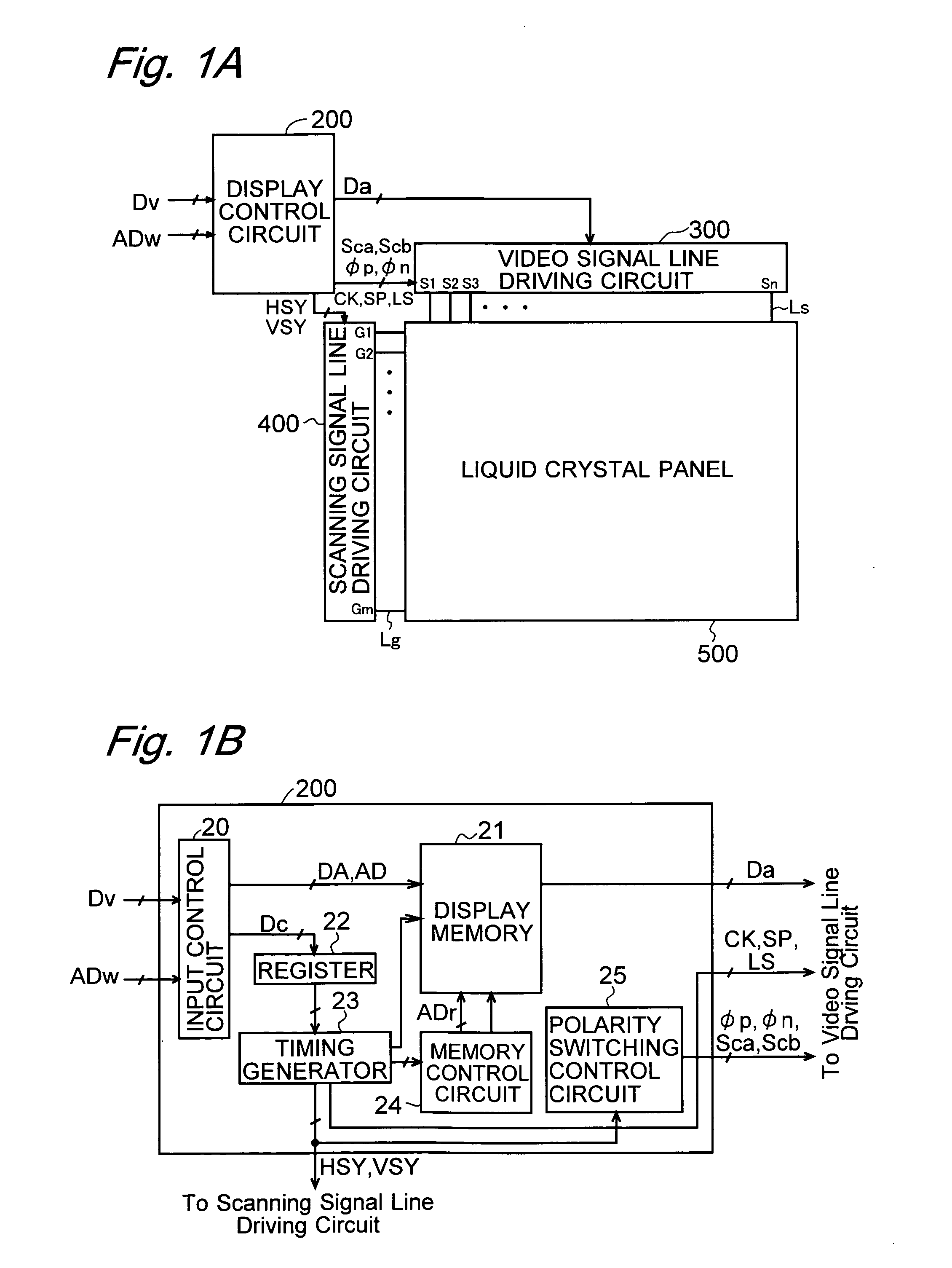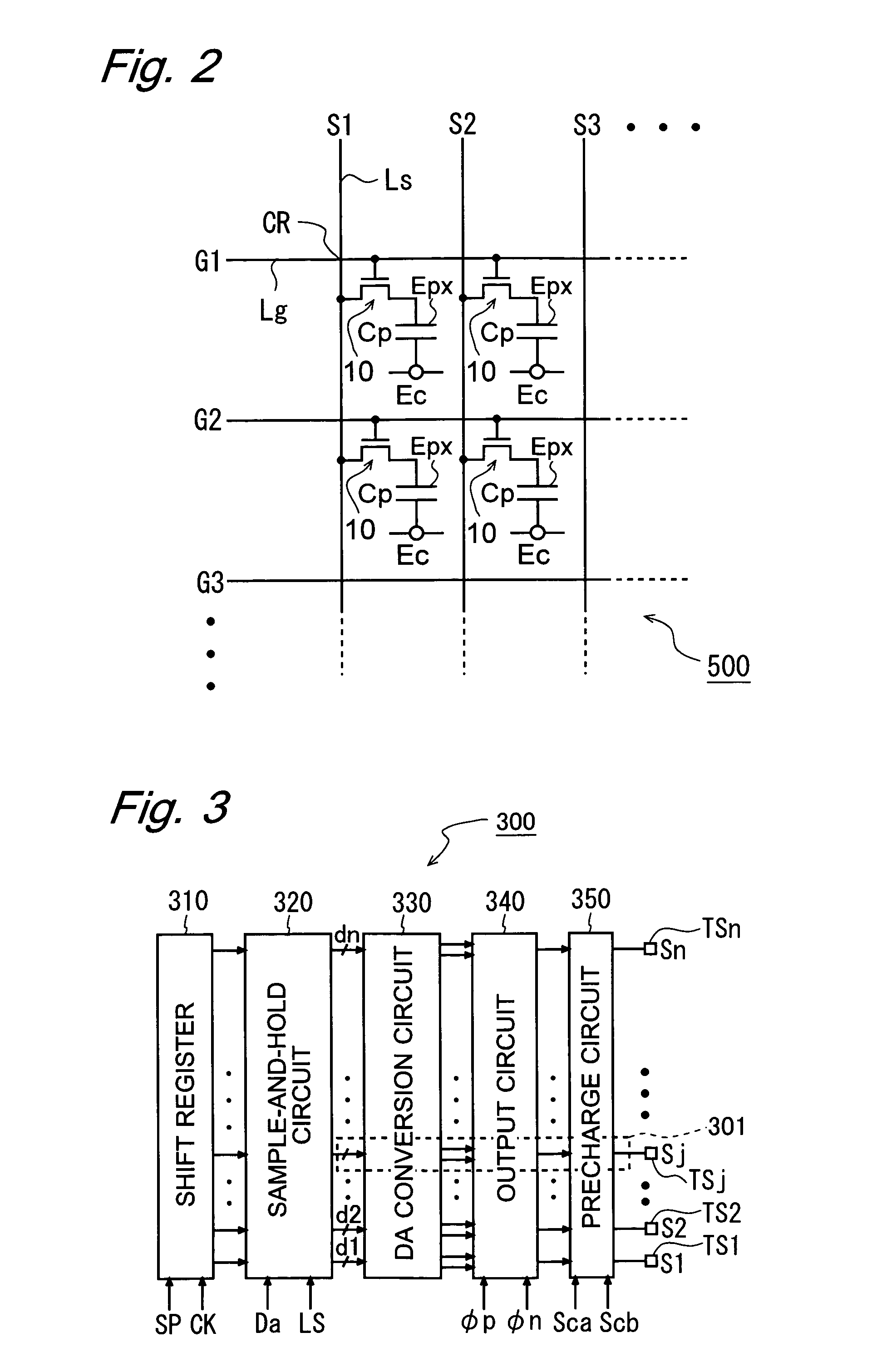[0014] It is thus an object of the present invention to provide a driving circuit and a driving method for driving a capacitive load by applying to the capacitive load a voltage whose polarity is periodically inverted, as in a
liquid crystal display device, wherein the driving circuit and the driving method can decrease the power consumption more than in conventional methods.
[0020] With this configuration, after the capacitive load has been charged by the output circuit, the capacitor becomes charged with the same potential and the same polarity as the capacitive load by connecting the capacitor in parallel to the capacitive load in a first predetermined period within the OFF period during which the output circuit is electrically disconnected from the capacitive load, and the capacitive load becomes charged to the same potential as the capacitor but at opposite polarity as in the first predetermined period by connecting the capacitor in parallel to the capacitive load but with opposite orientation in a second predetermined period within the OFF period. Thus, in the second predetermined period of the OFF period, the capacitive load is precharged by the accumulated charge of the capacitor, so that the
potential change of the capacitive load to be changed by the output circuit after the OFF period has passed is decreased in accordance with the
charge voltage of the capacitor, and becomes less than half the
potential change of when inverting the polarity. As a result, better results than in the conventional art can be attained with regard to reducing the power consumption of the driving circuit.
[0022] With this configuration, the capacitor is connected in parallel to the capacitive load with the same orientation in the first predetermined period within a second OFF period as an orientation of the second predetermined period in the first OFF period, so that the capacitor, which is charged in the second predetermined period within the first OFF period, is further charged with the same polarity in the first predetermined period within the second OFF period. Thus, the accumulated charge in the capacitor rises as the polarity inversion of the voltage applied to the capacitive charge is repeated, so that the potential change of the capacitive load that is to be changed by the output circuit becomes gradually smaller. As a result, the power consumption of the driving circuit can be reduced considerably.
[0028] With this configuration, in one of the first and second predetermined periods, the first switch inserted between one side of the capacitor and one side of the capacitive load is turned on and the second switch inserted between the other side of the capacitor and the predetermined precharge reference voltage is turned on, whereas in the other of the first and second predetermined periods, the fourth switch inserted between the one side of the capacitor and the predetermined precharge reference voltage is turned on and the third switch inserted between the other side of the capacitor and the one side of the capacitive load is turned on. Consequently, in the first predetermined period within the OFF period during which the output circuit is electrically disconnected from the capacitive load, the capacitor is connected in parallel to the capacitive load, and in the second predetermined period following thereafter, the capacitor is connected in parallel to the capacitive load but with opposite orientation. Thus, the potential change of the capacitive load that is to be changed by the output circuit becomes smaller, in accordance with the
charge voltage of the capacitor, and as a result, the power consumption of the driving circuit can be reduced more than in the conventional art.
[0034] With this configuration, as in the first aspect of the present invention, the capacitive load is precharged by the charge charged to the capacitor in the OFF period before the output circuit applies a voltage to the capacitive load, so that the potential change of the capacitive load to be changed by the output circuit after the OFF period has passed is decreased in accordance with the
charge voltage of the capacitor. As a result, the power consumption of the driving circuit can be decreased more than in the conventional art.
[0047] With this configuration, a capacitor and a connection switching circuit are provided for the capacitive load formed by the video
signal lines as well as the pixel
electrode and the common
electrode, and the capacitive load is precharged by the capacitor and the connection switching circuit in the OFF period, so that, of the potential changes of the video
signal lines at the time the polarity of the voltage applied to the capacitive load is inverted, the potential change to be changed by the output circuit becomes smaller in accordance with the charge voltage of the capacitor. Thus, the power consumption of the driving circuit of the video signal lines in a
liquid crystal display device or the like can be reduced more than in the conventional art.
 Login to View More
Login to View More  Login to View More
Login to View More 


